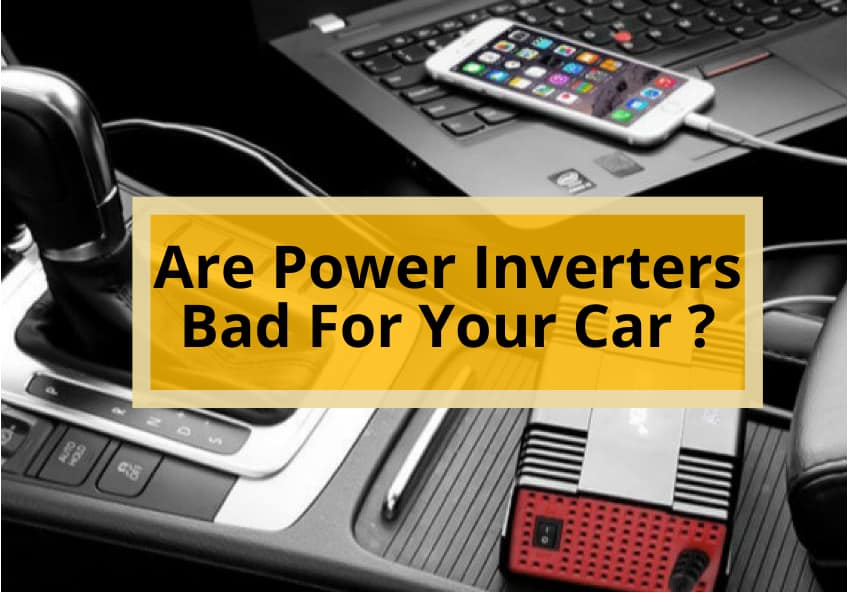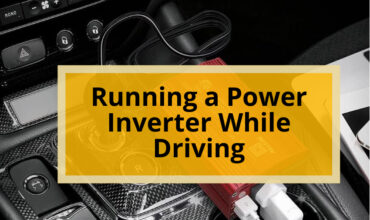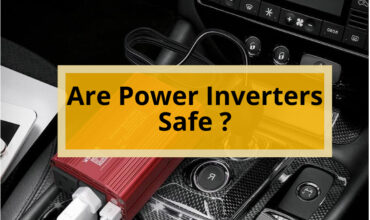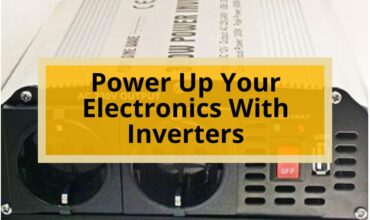Wondering if using a power inverter could potentially harm your vehicle’s battery? Power inverters are actually quite handy devices that allow you to power your electronic devices on the go. However, it’s important to use them sensibly and follow safety guidelines to prevent any issues.
Let’s explore more about power inverters and how to use them properly in your car.
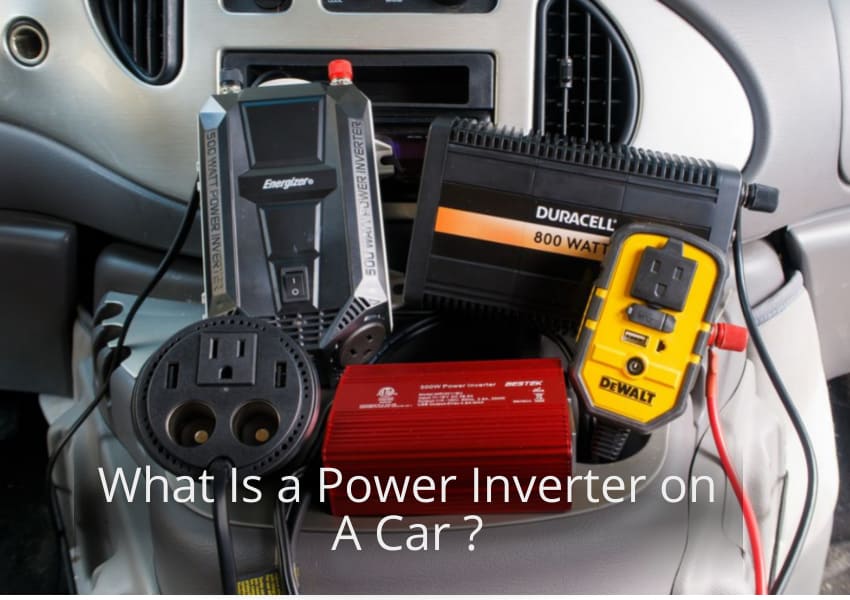
What Is a Power Inverter on A Car?
A power inverter on a car is a device that converts the 12-Volt DC circuit from a car’s battery into a 110-130-Volt AC circuit, which is the standard electrical current used by most household devices.
This allows you to power devices that would typically require a standard wall outlet. Its purpose is to provide a convenient and portable power source for electronic devices while on the go.
Types Of Inverters
There are several types of power inverters available on the market today, each with its own features and purposes. Also, choosing an appropriate power inverter will help reduce the chances of problems that could happen in your vehicle.
· Modified Sine Wave Inverters
Modified sine wave inverters are a type of power inverter that converts DC power from a car’s battery into AC power to run electronic devices and power tools. They are designed to provide a reliable and convenient power source for a variety of devices.
Unlike pure sine wave inverters, which produce a smooth and consistent wave output similar to the power supplied by electrical companies, modified sine wave inverters produce an approximation of the sine wave. While this may not be as clean as pure sine wave power, it is still suitable for powering most common electronic devices and appliances.
These inverters are suitable for charging phones, laptops, DVD players, and other small household appliances. However, some devices, such as certain medical devices, high-end audio systems, kitchen appliances, air conditioners, or high-power appliances, may not function properly or may experience reduced performance when powered by a modified sine wave inverter.
· Pure Sine Wave Inverters
On the other hand, pure sine wave inverters produce a smoother and more stable power output, making them ideal for delicate electronics and appliances. These inverters are typically more expensive but ensure the proper functioning and longevity of devices.
Pure sine wave inverters are used to power sensitive electronic devices. Unlike modified sine wave inverters, which produce an approximation of the sine wave, pure sine wave inverters provide a clean and stable power output. This makes them ideal for powering devices that are sensitive to power quality.
Pure sine wave inverters are suitable for a wide range of electronic devices, including laptops, phone chargers, DVD players, and even power tools. They are designed to replicate the same high-quality power that you would get from a standard electrical outlet at home, ensuring the safe and efficient operation of your devices.
In What Condition Using a Power Inverter Could Harm Your Car?
A power inverter can potentially harm your car if certain conditions are not met or precautions are not taken.
Firstly, overloading the cigarette lighter socket with a power inverter that exceeds the recommended wattage rating can damage both the inverter and the socket itself. It is important to check the wattage rating of your cigarette lighter socket and ensure that the power inverter does not exceed it.
Secondly, using a power inverter for an extended period of time without running the car’s engine can drain the car battery. Inverters draw power from the battery to convert it into AC power, and if the battery is not being charged, it can become drained, leading to difficulty starting the car or even permanent damage to the battery.
Lastly, if the power inverter is not properly installed or wired, it can potentially damage the car’s wiring system. Incorrect installation or faulty wiring can lead to short circuits, electrical fires, or damage to the car’s electrical components.
To ensure the safe use of a power inverter in your car, it is crucial to adhere to the recommended wattage rating, avoid running the inverter for extended periods without the car’s engine running, and properly install and wire the inverter to prevent damage to the car’s electrical system.
Factors to Consider When Choosing a Power Inverter
When choosing a power inverter for your car, there are several important factors to consider to avoid any harm that could happen to your car.
1. Determine Your Power Requirements
First, you need to determine your power requirements. Think about the electronic devices or appliances you plan to use with the inverter and their power needs. This will help you choose an inverter with the appropriate wattage rating.
2. A Power Inverter Safety Features
Safety features should also be a top priority. Look for inverters that have built-in protection against short circuits, overheating, and overloads. These features will not only protect your car’s electrical system but also ensure the safety of your electronic devices.
3. AC Outlets
Consider the number of AC outlets provided and the type of appliances you will be using. Some inverters provide multiple outlets, allowing you to power multiple devices simultaneously. Others may have specific outlets designed for high-power appliances.
4. Power Output
Power output is another crucial factor. Different inverters have different power output capabilities, so choose one that matches your needs. It’s better to slightly overestimate your power requirements to ensure the inverter can handle them.
5. Layout And Design
Consider the layout and design of the inverter to ensure that it fits well in your vehicle and is easy to access.
6. Available Space
Available space in the vehicle should be taken into account. Some power inverters are larger and require more space for installation.
7. Brand Reputation
Consider the reputation of the brand you are considering. Look for well-known and reputable manufacturers who have a track record of producing reliable and durable inverters.
8. Reading Reviews
Reading reviews from other customers will give you insights into the performance, reliability, and overall satisfaction of the inverter you are considering.
By considering these factors you can choose a power inverter that is suitable for your car and effectively powers your electronic devices.
Instructions To Be Followed for The Safe Use of The Power Inverter
When using a power inverter in your car, it is important to follow certain instructions to ensure its safe and efficient operation.
- Firstly, it is crucial to choose a power inverter that is suitable for your specific needs. Consider the power requirements of the electronic devices you plan to use and choose an inverter with the appropriate wattage rating.
- Additionally, make sure to connect the inverter directly to the car’s battery using the provided cables, rather than using the cigarette lighter or any other auxiliary power outlet. This will ensure a stable and reliable power source.
- Moreover, be mindful of the power draw of your devices and avoid running high-power appliances for extended periods of time, as this can drain the car’s battery.
- Lastly, always double-check the fuse boxes and fuse ratings to ensure they can handle the power output of the inverter and prevent any electrical issues.
Following these instructions will help you make the most of your power inverter while keeping your car and electronic devices safe.
Do Power Inverters Drain Your Vehicle’s Battery?
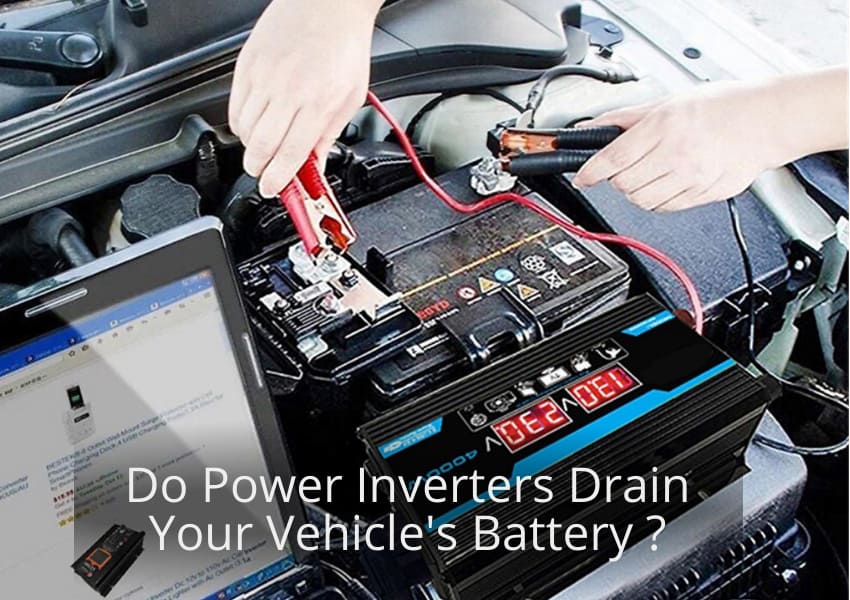
Yes, and this will happen fast if power inverters were not used correctly.
When connected to your car’s battery, power inverters convert the 12-volt DC power from your vehicle into 110–120-volt AC power, allowing you to use devices that require a higher voltage. While this is convenient, it can also drain your car’s battery if not used properly.
One important tip to minimize battery drain is to only use the power inverter when the vehicle’s engine is running. Running the inverter when the engine is off can quickly drain the battery. If you need to use the inverter for an extended period of time, consider alternative power sources such as a separate deep-cycle battery or a generator.
It’s also crucial to be mindful of the power requirements of the devices you’re using with the inverter. High-power appliances such as air conditioners or hair dryers can put a significant strain on your car’s electrical system and battery life.
How Long Will It Take a Power Inverter to Drain a Car Battery?
The duration it takes for a power inverter to drain a car battery depends on several factors. These include the size of the car’s battery, the capacity of the power inverter, and the power consumption of the device connected to the inverter.
A formula can be used to calculate the runtime of a power inverter:
Runtime (in hours) = Battery Capacity (in Ah) / Power Consumption (in Watts)
For example, if a car battery has a capacity of 50 Ah and the device connected to the power inverter consumes 100 Watts, the runtime would be 0.5 hours or 30 minutes.
Overall, the duration it takes for a power inverter to drain a car battery will vary depending on specific factors, as we have mentioned before. That is why it is important to assess the power requirements and plan accordingly to prevent unnecessary strain on the car battery.
Frequently Asked Questions
Should Anyone Get a Power Inverter?
If you are a road tripper, camper, or small business owner who relies on electronic devices like laptops, getting a power inverter for your car is a wise choice. It will provide you with the power source you need to stay connected, productive, and comfortable in various situations.
Can I use a power inverter while driving?
Yes, you can use a power inverter while driving, but it is essential to exercise caution and ensure the inverter is securely installed to avoid any interference with driving or the vehicle’s electrical systems.
Can A Power Inverter Damage My Car’s Electrical System?
When used correctly and within the limitations of your vehicle’s electrical system, power inverters should not cause damage. However, it is crucial to avoid overloading the inverter or exceeding its power output.
It is also advisable to follow the manufacturer’s instructions and consult a professional if you are unsure about the compatibility between the inverter and your car’s electrical system.
Can I leave a power inverter plugged in when the car is turned off?
It is generally not recommended to leave a power inverter plugged in when the car is turned off. Even in standby mode, power inverters can draw a small amount of power from the battery, which could lead to battery drain over time.
To avoid unnecessary strain on your car’s battery, it is best to unplug the inverter when not in use or when the car engine is turned off.
What Kinds of Devices Can I Use with A Power Inverter?
When it comes to using a power inverter, you have a wide variety of devices at your disposal. The type of device you can use with a power inverter depends on its wattage rating.
Power inverters come in various sizes, ranging from low-wattage inverters suitable for small electronic devices to high-wattage inverters capable of powering larger appliances.
For example, if you have a low-wattage power inverter, you can easily use it to charge your phone or laptop. Phone chargers and laptop chargers typically have low power requirements, making them compatible with most power inverters.
But power inverters aren’t limited to just charging devices. With a higher-wattage power inverter, you can also power small televisions, gaming systems, and other electronics within the power capacity of the inverter.
It’s important to consider the wattage rating of the power inverter and match it with the power requirements of the devices you want to use. This ensures that the inverter can effectively power the devices without straining their capacity.
How Power Inverters Are Tested?
When testing power inverters, several devices are used to assess their capabilities. These devices include laptops, televisions, gaming systems, and other electronic devices that typically rely on household outlets.
· The testing process involves measuring the wattage that the power inverter can support.
· The power inverter’s fuse protection is evaluated during testing. This is crucial for preventing damage to the inverter and connected devices in the event of a power surge or overload.
· The presence of USB and AC ports is also assessed. USB ports allow for the charging of phones, tablets, and other USB-powered devices, while AC ports enable the usage of appliances and electronics that require standard household outlets.
· The length of the power cord is considered. A longer power cord provides greater flexibility in terms of where the inverter can be placed and connected to power sources.
By thoroughly testing power inverters based on these criteria, manufacturers can ensure that their products meet the needs and expectations of consumers.
Could A Power Inverter’s Fuse Blow, And What to Do If That Happened?
A power inverter’s fuse may blow under certain circumstances, such as when there is a power surge or when the connected devices draw more power than the inverter can handle.
If this happens, it is important to take the necessary steps to ensure the safety of both the inverter and the connected devices.
Firstly, locate the fuse on the power inverter. The fuse is typically located near the power input or output ports, and it is usually a small, cylindrical component. Refer to the user manual or manufacturer’s instructions for the specific location of the fuse on your power inverter.
If the fuse has blown, it will need to be replaced. To replace the fuse, follow these instructions:
1. Ensure that the power inverter is unplugged and turned off.
2. Carefully remove the blown fuse from its socket using a fuse puller or a pair of tweezers.
3. Obtain a replacement fuse with the same rating as the blown fuse. The fuse rating may be indicated on the fuse or in the user manual.
4. Insert the new fuse into the fuse socket, making sure it fits securely.
5. Reassemble any covers or panels that were opened during the replacement process.
Once you have replaced the fuse, plug in the power inverter and test it with a low-power device before connecting high-power appliances or electronic devices. If the fuse blows again, it may indicate a larger electrical issue, and it is recommended to consult a professional for further inspection and troubleshooting.
Could A Car’s Fuse Blow, And What to Do If That Happened?
A car’s fuse can blow for various reasons, such as a power surge or a faulty electrical component.
When a fuse blows, it interrupts the flow of electricity to the affected circuit, preventing further damage to the car’s electrical system. If you encounter a blown fuse in your car, follow these steps to address the issue:
1. Start by locating the fuse boxes in your vehicle. Most cars have at least two fuse boxes: one in the engine compartment and another inside the cabin. Consult your car’s manual to find the exact locations.
2. Once you’ve found the fuse box, open the cover or panel to access the fuses inside. Many fuse boxes have a diagram or labeling system to help you identify each fuse’s circuit.
3. Identify the fuse corresponding to the circuit that has stopped working. The blown fuse will have a broken metal strip inside, indicating that it needs to be replaced.
4. Before replacing the fuse, make sure the car’s ignition is turned off, and any electronic devices are disconnected.
5. Obtain a new fuse with the same amperage rating as the blown fuse. Using a fuse with a higher amperage can be dangerous and may damage the car’s electrical system.
6. Carefully remove the blown fuse from its socket using a fuse puller or a pair of tweezers. Insert the new fuse into the socket, ensuring it fits securely.
7. Once the new fuse is in place, reassemble any covers or panels that were opened during the process.
Remember to address the underlying cause of the blown fuse to prevent it from happening again. If the fuse continues to blow repeatedly, it may indicate a more significant electrical issue in your car, and professional assistance should be sought.
How Much Power of a Car Inverter Is Enough?
The wattage range of car inverters can vary, from lower capacities of around 150 watts to larger capacities of 3000 watts or more.
In Conclusion
Power inverters can provide a convenient power source for various electronic devices and tools while on the road. By selecting an appropriate capacity inverter, using it responsibly, and considering alternative power sources, when necessary, you can ensure the safe and efficient use of power inverters in your car without negatively impacting your battery or electrical system.
